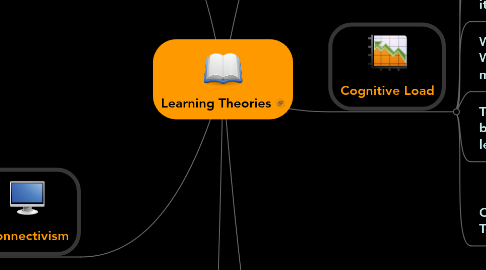
1. Behaviourism
1.1. Reinforcement to produced desired behaviour
1.2. Teacher directed, often lecture mode; practice drills
1.3. Positive and negative reinforcement
1.4. Behaviourist Technologies:
1.4.1. Skill and drill
1.4.2. Computer games with a reward or points for reward
1.4.3. Math Blaster
2. Connectivism
2.1. Knowledge exists out in the world and it is up to the learner to find and access it
2.2. Learning is the process of developing connections and networks
2.3. Knowledge is distributed across a network and involves connecting specialized nodes of information
2.4. Teaching takes on more of a role of providing the ways and means for students to find the information they are seeking.
2.5. Connectivist Technologies
2.5.1. Twitter, Facebook,
2.5.2. MOOC's
2.5.3. Facetime, Skype
2.5.4. email, webcam, texts,
2.5.5. search engines, data bases, servers
2.5.6. TED Talks, YouTube
2.5.7. Wiki Everything
3. Technology Theories
3.1. SCOT
3.1.1. Social Construction of Technology
3.1.2. Human action seen to affect technology, not the other way around
3.1.3. No matter how good or bad a piece of technology is, its success is determined by social acceptance (often gained through advertising)
3.1.4. SCOT can be helpful in decoding the mystery behind the success or failure of a piece of technology. Sometimes new technologies emerge almost simultaneously and one tends to reign supreme, SCOT can help determine why this happens.
3.2. Media Ecology
3.2.1. The notion that technology, and the use of technology play a role in human affairs and decision making
3.2.2. How media affects human perception, how we act, react and think
3.2.3. Media Ecology differs from the SCOT model of technology in that that SCOT model sees that human affect technology, it's success or failure
4. Constructivism
4.1. Constructing one's own knowledge from your own experiences
4.2. Learning should happen in realistic situations, interacting with your environment
4.3. Teacher is no longer the sage on the stage but the guide on the side
4.4. Constructivist Technologies:
4.4.1. Tangible real world work
4.4.2. Activities such as: building with Lego, creating robots
4.4.3. Project based learning
4.4.4. Google sites, Wiki Sites
5. Cognitive Load
5.1. Previous learning serves as foundation for new learning.
5.2. Memory systems are active processors of information
5.3. When learning has meaning, it will last longer in the mind.
5.4. We have two types of memory, Working Memory and Long Term memory
5.5. Teachers provide scaffolding for learning, but need to be aware of overload where learning becomes lost.
5.6. Cognitive Load Technologies
5.6.1. Mnemonics, word games, mind mapping
5.6.2. Word clouds, Prezi, Inspiration
5.6.3. Metaphors
5.6.4. Chat groups
6. Theories and Frameworks
6.1. Philosophy of Teachnology
6.1.1. combines teaching philosophy with technology
6.1.2. looks at a teachers core beliefs on how the use of technology is integrated into their teaching and into their Philosophy of Teaching
6.1.3. Just like a Philosophy of Teaching, Teachers may take steps to formalize their beliefs about teachnology use by writing them down
6.1.4. May be used as part of a teachers formalized goal setting TPGP
6.1.5. Professional Development can be used specifically for improving technology use in the classroom
6.2. TPACK
6.2.1. A Venn diagram is used to show how pedagogy, content and technology overlap and intersect
6.2.2. TPACK focuses on three types of understanding/knowledge that a teacher must possess to be successful in the classroom.
6.2.2.1. Pedagogy
6.2.2.2. Content
6.2.2.3. Technology
6.2.3. TPACK attempts to identify the areas in which teachers can improve technology use in the classroom
6.2.4. When a teacher can see visually with a Venn diagram where their strengths and deficits are, they are able to focus learning in new areas.
